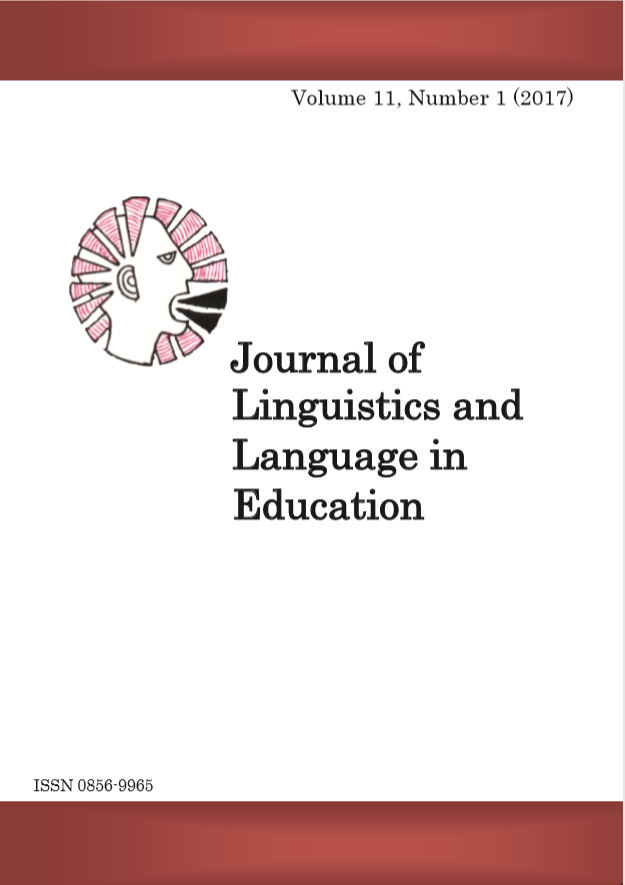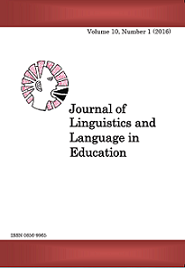Ulinganishaji wa Maumbo na Miundo ya Ukanushi katika Lugha ya Kiswahili naKiingereza
Abstract
English is one of the languages in which negation has intensively been
discussed compared to Kiswahili where this category has been
discussed by just a few scholars. This situation forces scholars who
want to write about negation in Kiswahili to review negation in English
as part of their literature review. This is due to the fact that the
libraries in Tanzanian higher learning institutions are full of English
based language literature presumably because a lot of research involved
English while research in languages like Kiswahili is still infant. That
being the case, it is obvious that analysis of negation in the Kiswahili
language is always affected by English negation analysis principles.
References
Marejeleo
Akidah, M. A. (2013). Phonological and Semantic Change in
Language Borrowing. The Case of Arabic Words Borrowed
into Kiswahili. International Journal of Education and
Research, 1(4), 1-20. Kutoka
www.ijern.com/images/April2013/42.pdf
Ashton, E. O. (1944). Swahili Grammar (Including Intonation).
London: Longman Group Ltd.
Barbara, F. (1998). A History of English: A Sociolinguistic Approach .
Oxford: Blackwell.
Beaudoin-Lietz, C. (1999). Formatives of Tense, Aspects Mood and
Negation intheVerbal Construction in Standard Swahili .
Tasnifu ya Uzamivu (Haijachapishwa). Memorial University
of Newfoundland.
Contini-Morava, E. (1989). Discourse Pragmatics and Semantic
Categorization: The Case of Negation and Tense-Aspect with
Special Reference to Swahili . Berlin: Mouton de Gruyter.
Crystal, D. (1993). A Dictionary of Linguistics and Phonetics .
Blackwell: Oxford University Press.
Curme, G. O. (1931). Syntax. Boston and Tokyo: D.C. Heat and
Company & Maruzen Company Ltd.
Journal of Linguistics and Language in Education Volume 14, Number 2 (2020) |17
Dahl, Ö. (1979). Typology of Sentence Negation.Linguistics 17:79 €“
Haegeman, L. (1995). The Syntax of Negation. New York: Cambridge
University Press.
Habwe, J. & Karanja, P. (2004). Misingi ya Sarufi . Nairobi: Phoenix
Press.
Jespersen, O. (1917). Negation in English and other Languages .
Copenhagen: A. F. Host.
Heusinger, K., Portner, P. & Maienborn, C. (2011). The Handbook of
Natural Language Meaning. Berlin: Mouton de Gruyter.
Horn, L. (2001). A Natural History of Negation. Chicago: CSL1
Publications.
Horn, L. & Kato, Y. (2000). Negation and Polarity: Syntactic and
Semantic Perspectives. Oxford: Oxford University Press.
Kapinga, M.C. (1983). Sarufi Maumbo ya Kiswahili Sanifu. Dar es
Salaam: Taasisi ya Uchunguzi wa Kiswahili.
Kiango, J. (2002). Nafasi ya Kiswahili katika Ujenzi wa Jamii Mpya
ya Afrika Mashariki. Swahili Forum, IX:143-154.
Kihore, Y. M., Massamba, D. P. B. & Msanjila, Y.P. (2009). Sarufi
Maumbo ya Kiswahili Sanifu (SAMAKISA). Chuo Kikuu cha
Dar es Salaam: TUKI.
Klima, E. S. (1964). Negation in English. ni J. A. Fodor & J. J. Katz
(eds.). TheStructure of Language : Readings in the
Philosophy of Language . New York: Prentice-Hall: 246-323.
Lindstad, A. M. (2007). Analyses of Negation: Structure and
Interpretation. Tasnifu ya Uzamivu (Haijachapishwa). Chuo
Kikuu cha Oslo.
Mbaabu, I. (2007). Historia ya Usanifishaji wa Kiswahili. Dar es
Salaam: TUKI.
Maganga, G. (1991). A Study of the Morphophonology of Standard
Kiswahili, Kipemba, Kitumbatu and Kimakunduchi. Tasnifu
ya Uzamivu (Haijachapishwa). Chuo Kikuu cha Dar es
Salaam.
Massamba, P. B., Kihore, Y. M. & Hokororo, J. I. (2012). Sarufi
Miundo ya Kiswahili: Sekondari na Vyuo . Dar es Salaam:
TUKI.
Miestamo, M. (2007). Negation: An Overview of Typological
Research. Language and Linguistic Campass, 5(1): 552 €“570.
Mgullu, R. S. (1999). Mtalaa wa Isimu. Nairobi: Longman.
Nchimbi, A. S. (1995). Je, Mang ' ong ' o ni Fonimu au si Fonimu katika
Kiswahili Sanifu? Baragumu, 25-39. Maseno: Chuo Kikuu
cha Maseno.
| Ulinganishaji wa Maumbo na Miundo ya Ukanushi
Ngonyani, D. (2001). The Morphosyntax of Negation in Swahili.
Swahili Forum, VII:17-33.
Obuchi, S. M. & Mukhwana, A. (2010). Muundo wa Kiswahili. Ngazi
na Vipengele . Nairobi: A~Frame Publishers.
Poutsma, H. (1929). A Grammar of Late Modern English. Part 11:
The Sentence. Second Half. Groningen: P. Noordhoff.
Polomé, E. (1967). Swahili Language Handbook. Washington: Center
Schadeberg, T. C. (1984). A Sketch of Swahili Morphology. Köln:
Rüdiger Köppe Verlag.
TATAKI (2013). Kamusi ya Kiswahili Sanifu. Toleo la 3. Nairobi:
University of Dar es Salaam na Oxford University Press.
Tottie, G. (1991). Negation in English. San Diego, Calif: Academic
Press. Imepakuliwa 15/01/2016 kutoka
https://searchworks.stanford.edu/view/726258
Vitale, A. (1981). Swahili Syntax. Dordrecht: Foris Publications.
Wesana-Chomi, E. (2013). Kitangulizi cha Mofolojia ya Kiswahili.
Dar es Salaam: TATAKI.
Whiteley, W. (1974). Swahili: The Rise of a National Language .
London: Methuen.
Whiteley, W. H. (1956). Studies in Swahili Dialect 1: Kimtang ' ata.
East African Swahili Committee.
Downloads
Published
Issue
Section
License
Copyright © by Department of Foreign Languages and Linguistics, University of Dar es Salaam
All rights reserved. No part of this publication may be reproduced or transmitted in any form or by any means, electronic or mechanical, including photocopying, recording, or any information storage or retrieval system, without permission in writing from the publisher, except for short extracts in fair dealing, for research or private study, critical scholarly review or discourse with an acknowledgement.



